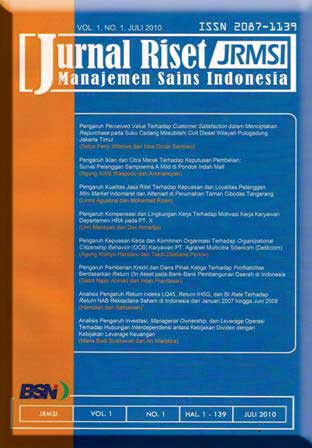MODEL PERILAKU KEPUTUSAN PEMBELIAN PRODUK BERBASIS AGEN: FENOMENA PENGARUH MEDIA SOSIAL
DOI:
https://doi.org/10.21009/JRMSI.012.2.07Keywords:
agent-based modelling, Instagram, product-purchase decision, social media influencer, social interaction.Abstract
Influencer media sosial dalam pemasaran digital telah menjadi fenomena baru karena mereka
dapat menggantikan peran influencer tradisional. Namun, diskusi tentang fenomena ini masih
kurang jelas dalam literatur akademis sejauh pengetahuan kita. Penelitian ini bertujuan untuk
memahami peran social media influencer dalam interaksi sosial dan implikasinya terhadap
keputusan pembelian produk kecantikan untuk memberikan gambaran suatu perusahaan dalam
mengambil keputusan bisnis menggunakan Instagram. Simulasi pemodelan berbasis agen
(ABM) digunakan untuk memahami fenomena ini. Simulasi tersebut merupakan kombinasi
dari pendekatan deduksi yang memanfaatkan teori perilaku terencana (TPB) dan pendekatan
induksi melalui observasi kehidupan nyata. Beberapa parameter digunakan untuk mendukung
proses simulasi, antara lain jumlah pengikut, jumlah suka/komentar, jumlah posting, dan daya
tarik influencer. Berakhir dengan memutuskan untuk membeli suatu produk atau tidak, yang
diidentikkan dengan angka penjualan. Penelitian ini mengklasifikasikan tiga influencer yang
berbeda dengan karakteristik yang telah ditentukan. Simulasi menunjukkan bahwa penjualan
produk menggunakan Influencer [B] menghasilkan penjualan tertinggi melalui iterasi
berulang, diikuti oleh Influencer [A] dan Influencer [C]. Beberapa parameter juga menjelaskan
fenomena social media influencer dalam keputusan pembelian produk. Studi ini menemukan
bahwa jumlah konten yang diposting merupakan parameter paling signifikan dalam keputusan
pembelian produk. Namun, parameter lain juga memberikan kontribusi yang signifikan.
Melalui kombinasi yang tepat, organisasi dapat mempertimbangkan parameter ini mengenai
kontribusi influencer media sosial terhadap penjualan produk mereka. Keterbatasan penelitian
dan rekomendasi disajikan secara lengkap dalam artikel ini.
References
Awaluddin, I., & Hamid, W. (2019). Interaction of social identity, empathy and planned behavior theories to understand domestic product purchasing intention. Problems and Perspectives in Management, 17(1), 95–102. https://doi.org/10.21511/ppm.17(1).2019.09
De Veirman, M., Cauberghe, V., & Hudders, L. (2017). Marketing through instagram influencers: The impact of number of followers and product divergence on brand attitude. International Journal of Advertising, 36(5), 798–828. https://doi.org/10.1080/02650487.2017.1348035
Garcia, R., & Jager, W. (2011). From the Special Issue Editors: Agent-Based Modeling of Innovation Diffusion. Journal of Product Innovation Management, 28(2), 148–151. https://doi.org/10.1111/j.1540-5885.2011.00788.x
Giampietri, E., Verneau, F., Del Giudice, T., Carfora, V., & Finco, A. (2018). A Theory of Planned behaviour perspective for investigating the role of trust in consumer purchasing decision related to short food supply chains. Food Quality and Preference, 64(June), 160–166. https://doi.org/10.1016/j.foodqual.2017.09.012
Gomber, P., Kauffman, R. J., Parker, C., & Weber, B. W. (2018). On the Fintech Revolution: Interpreting the Forces of Innovation, Disruption, and Transformation in Financial Services. Journal of Management Information Systems, 35(1), 220–265. https://doi.org/10.1080/07421222.2018.1440766
Jin, S. V., Muqaddam, A., & Ryu, E. (2019). Instafamous and social media influencer marketing. Marketing Intelligence and Planning, 37(5), 567–579. https://doi.org/10.1108/MIP-09-2018-0375
Jinyevu, S. A., Mkonya, V. L., & Dantur, M. L. (2018). Exploring the Use of Consumer Endorser Strategy in Social Media Product Promotion Advertisement and Its Impacts on Young Consumers Behavior in Tanzania. Proceedings of the 15th International Conference on Innovation & Management, 764–770.
Macal, C. M., & North, M. J. (2009). Agent-based modeling and simulation. Proceedings of the 2009 Winter Simulation Conference, 86–98.
Martis, M. S. (2006). Validation of simulation based models: A theoretical outlook. Electronic Journal of Business Research Methods, 4(1), 39–46.
Merminod, N., Large, R. O., & Paché, G. (2019). Procurement of advanced logistics services: proposition of a reasoned action model of individual buying behavior. Supply Chain Forum, 20(3), 169–184. https://doi.org/10.1080/16258312.2018.1555635
Miles, J. G. (2013). Instagram Power: Build Your Brand and Reach More Customers with the Power of Pictures (1st Editio). McGraw-Hill Education.
Miralles, F., Giones, F., & Gozun, B. (2017). Does direct experience matter? Examining the consequences of current entrepreneurial behavior on entrepreneurial intention. International Entrepreneurship and Management Journal, 13(3), 881–903. https://doi.org/10.1007/s11365-016-0430-7
Nuttavuthisit, K., & Thøgersen, J. (2017). The Importance of Consumer Trust for the Emergence of a Market for Green Products: The Case of Organic Food. Journal of Business Ethics, 140(2), 323–337. https://doi.org/10.1007/s10551-015-2690-5
Pan, J. Y., & Truong, D. (2018). Passengers' intentions to use low-cost carriers: An extended theory of planned behavior model. Journal of Air Transport Management, 69(November 2017), 38–48. https://doi.org/10.1016/j.jairtraman.2018.01.006
Pappas, N. (2017). Effect of marketing activities, benefits, risks, confusion due to over-choice, price, quality and consumer trust on online tourism purchasing. Journal of Marketing Communications, 23(2), 195–218. https://doi.org/10.1080/13527266.2015.1061037
Piroth, P., Ritter, M. S., & Rueger-Muck, E. (2020). Online grocery shopping adoption: do personality traits matter? British Food Journal, 122(3), 957–975. https://doi.org/10.1108/BFJ-08-2019-0631
Schwaninger, M., & Grosser, S. (2008). System Dynamics as Model-Based Theory Building. Systems Research AndBehavioral Science, 25, 447–465. https://doi.org/10.1002/sres
Tuten, T. L. (2008). Advertising 2.0: Social Media Marketing in a Web 2.0 World. Preager.
Watts, D. J., & Dodds, P. S. (2014). Influentials, Networks, and Public Opinion Formation. Journal of Consumer Research, 34(4), 441–458.
Yin, R. K. (2014). Case Study Research Design and Methods (5th ed.). Sage.
Youn, S., & Jin, S. V. (2017). Reconnecting with the past in social media: The moderating role of social influence in nostalgia marketing on Pinterest. Journal of Consumer Behavior, 16(6), 565–576. https://doi.org/10.1002/cb.1655
Downloads
Published
How to Cite
Issue
Section
License

Articles in Jurnal Riset Manajemen Sains Indonesia are Open Access articles published under the Creative Commons CC BY-NC-SA License. This license permits use, distribution and reproduction in any medium for non-commercial purposes only, provided the original work and source is properly cited. Any derivative of the original must be distributed under the same license as the original.











